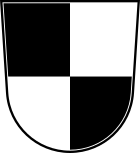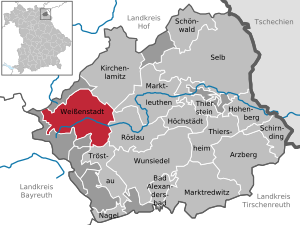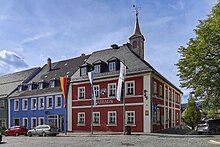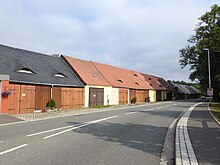Weißenstadt
| coat of arms | Germany map | |
|---|---|---|

|
Coordinates: 50 ° 6 ' N , 11 ° 53' E |
|
| Basic data | ||
| State : | Bavaria | |
| Administrative region : | Upper Franconia | |
| County : | Wunsiedel in the Fichtel Mountains | |
| Height : | 630 m above sea level NHN | |
| Area : | 42.24 km 2 | |
| Residents: | 3099 (Dec. 31, 2019) | |
| Population density : | 73 inhabitants per km 2 | |
| Postal code : | 95163 | |
| Area code : | 09253 | |
| License plate : | WUN, MAK, REH , SEL | |
| Community key : | 09 4 79 166 | |
| City structure: | 21 districts | |
City administration address : |
Kirchplatz 1 95163 Weißenstadt |
|
| Website : | ||
| Mayor : | Frank Dreyer ( SPD ) | |
| Location of the city Weißenstadt in the district of Wunsiedel in the Fichtel Mountains | ||
Weißenstadt is a town in the Upper Franconian district of Wunsiedel in the Fichtel Mountains .
geography
The city is embedded in the valley of the Eger between Waldstein , Rudolfstein and Höllpass on the plateau of the Fichtelgebirge . Weißenstadt is about halfway between Hof (Saale) and Bayreuth .
City structure
The city of Weißenstadt is divided into 21 districts:
history
middle Ages
The place first appeared in a document in 1299 as "Weißenkirchen" ( Latin : Alba Ecclesia ) and belonged to the domain of the nearby Rudolfstein Castle . This was first mentioned in 1317 and was then owned by the Lords of Hirschberg , who had received it from the Counts of Henneberg as a fief. The Hennebergers had taken over the area around the Rudolfstein from the inheritance of the Andechs-Meranians . Not long afterwards, the Rudolfstein and with it the village of Weißenkirchen at its feet was under the control of the Waldsassen monastery , which in 1347 sold this property to the burgraves Johann II and Albrecht the Beautiful of Nuremberg. A little later they elevated the place to a city, because in 1368 the settlement was first called Weißenstadt. As a result, Weißenstadt gained great importance through the tin mining and tin processing operations in the area . Already in the 14th century there was a separate “tin dish” there. The 1398 by burgrave Johann III. The "Zeidelgericht" instituted by Nuremberg in Weißenstadt refers to the extensive forest beekeeping here .
Early modern age
From the 16th to the 18th centuries, rock crystals were also mined in Weißenstadt , which were used, for example, in the construction of the New Palace in the Bayreuth Hermitage . Towards the end of the 15th century, the Hirschbergers, who had acted as Hohenzollern bailiffs since the sale of the Rudolfstein to the Nuremberg burgraves , left the climatically unfavorable hilltop castle Rudolfstein and moved their official residence to Weißenstadt, where they owned two noble seats. These castles fell victim to the great city fire of 1823; there are no more remains of it to be seen. With the administrative reform of 1613, the posts of aristocratic bailiffs in the Sechsämterland were abolished; Weißenstadt became the seat of a margravial judge's office. Besides Wunsiedel , Weißenstadt was the only town in the Sechsämterland that had a city wall . In 1818 the political municipality was established.
19th and 20th centuries
In 1899 Weißenstadt also got a railway connection. A branch line closed in 1993 connected the city near Kirchenlamitz-Ost (Niederlamitz) with the Weiden – Oberkotzau line .
Incorporations
On January 1, 1978, the communities of Franconia and Voitsumra and parts of the area of the dissolved community of Reicholdsgrün were incorporated.
Population development
Between 1988 and 2018, the population decreased from 3,734 to 3,113 by 621 inhabitants or 16.6%.
politics
In the mayoral election in 2020, Frank Dreyer ( SPD ) prevailed again with 54.01% against Matthias Beck ( CSU ) with 32.12% and Thomas Miksch ( FW ) with 13.87%.
The city council has 16 members:
2020-2026 parliamentary term
- SPD 6 seats
- CSU 7 seats
- Free voters 3 seats
2014–2020 parliamentary term
- SPD 7 seats
- CSU 7 seats
- Free voters 2 seats
2008-2014 electoral term
- SPD 7 seats
- CSU 6 seats
- Free voters 3 seats
2002–2008 parliamentary term
- SPD 4 seats
- CSU 7 seats
- Free voters 3 seats
- ÜWG 2 seats
Churches
- Evangelical Lutheran parish
- Catholic parish with the parish church Maria Immaculata
Attractions

- Catholic parish church Maria Immaculata from 1936
- The Protestant town church St. Jakobus was rebuilt using the old outer walls after the fire of 1823.
- The Evangelical Church of the Holy Trinity has preserved its rich furnishings from the 17th century.
- In the spa gardens, near the row of barns on Bayreuther Strasse, are the ruins of Erhard Ackermann's stone cutting shop .
- The drugstore museum in Sack's Destille, which is open to the public by arrangement, is located at Kirchenlamitzer Straße 12, connected to the Weißenstädter Unterwelt, a crystal mine.
- Between the lake and the campsite there is one of the first evidence of stone cutting, a granite fish box.
- The little museum
- The rows of barns that were typical of the Fichtelgebirge in the past are still largely preserved in Weißenstadt. In a former barn there is an information point of the Fichtelgebirge nature park about the river and the Eger biotope .
- Felsenkeller in the vicinity of the city
- The castle ruins and natural monuments Rudolfstein and Waldstein
- Parts of the city wall
- Former Werra tin mine on Rudolfstein
Weißenstadt basement world
A system of underground warehouses and underground cellars is located in the so-called Weißenstädter Kellerwelt , which comprises one hundred and thirty underground storage rooms on an area slightly larger than a soccer field. The cellars together form a “labyrinthine system of storage rooms and widely ramified corridors” that has not yet been systematically recorded. According to Gerald Kastl, a member of the Weissenstadt Cellar Research Working Group, the cellars were laid out in front of the city from 1756 as storage rooms for the storage of the potatoes that were newly introduced at the time.
Economy and Infrastructure
education
- Weissenstadt primary school
Recreation

The 48 ha large white townspeople lake is located at the edge of town. It is accessible from all sides and offers many leisure activities such as a beach volleyball and a basketball court and you have the opportunity to practice some water sports. The 4.2 kilometer long, continuously paved lake path is suitable for inline skating and walking. The spa park and the landscape around the lake invite you to relax and unwind. On August 18, 2007, a radon spa and relaxation hotel was opened on the south-west bank of the lake.
Thermal bath
The Siebenquell® GesundZeitResort was opened on October 30, 2016 on the south-west bank of the Weißenstädter See. This includes around 6,200 square meters of sauna area and 1,500 square meters of water. The fluoride-containing sulfur thermal water is pumped from a depth of 1835 meters, the pools have temperatures of 31 to 34 degrees.
Leisure and sports facilities
- Bathing possibilities
- Natural swimming pool
- Bathing areas close to the city at the northern end of the Weißenstädter See
- modern indoor swimming pool in the spa hotel at the southern end of the Weißenstädter See (only for hotel guests)
- Siebenquell thermal baths on the Weißenstädter See
- Kneipp facilities
- Kneipp facility on the way from the parking lot to the northwest end of the lake
- Kneipp facility on the cycle path to Kirchenlamitz (about three kilometers from the center of Weißenstadt)
- water sports
- Surf club with storage space at the southern end of the Weißenstädter See
- Sailing club with storage area and slipway at the southern end of the Weißenstädter See
- Two pedal boat rentals at the sailing club and on the peninsula
- camping
- Campsite near the lake with various areas for long-term parkers , mobile caravans and tents
- Tennis courts
- System with three spaces at the parking lot near the western end of the Weißenstädter See
- basketball
- Tar place in the east of the Weißenstädter See near the weir
- Sports and soccer fields
- A tournament and a training field near the natural swimming pool
- Athletics facility at the primary and secondary school
- Sports halls
- Multipurpose sports facility of the elementary and secondary school
- Sports hall of the gymnastics club
- Trails
- Several cross-country trails maintained by WSV Weißenstadt in the direction of Schneeberg and Waldstein with connections to the cross-country trails in neighboring communities
- Sledding
- Small toboggan hill in the spa park
- Toboggan slope on the Großer Waldstein directly at the Waldsteinhaus
- Bike paths
- Signposted mountain bike routes in the surrounding forests (Schneeberg and Waldstein routes)
- Asphalted circular path around the Weißenstädter See (also for inline skiers)
- Gravel road on the former railway line to Kirchenlamitz
- The approximately three kilometers away Saale source is the starting point of the 427 km long cycle path Saale
- Passing the Eger source over the Schneeberg pass (798 m), after about 5 kilometers you come to the beginning of the (Weiß-) Main-Radwanderweg on the former railway line from Bischofsgrün to Bad Berneck (continuously asphalted and on the opposite side of the river)
- Asphalted secondary routes in the direction of Grub, Birk, Ruppertsgrün for round trips and tours
- Hiking trails
- E3 (approx. 6950 km) from Istanbul to Cape St. Vincent / Santiago de Compostela (E)
- E6 (approx. 5200 km) from Kilpisjärvi to the Dardanelles
- Marked Jakobsweg (pilgrimage route over the Kleiner Waldstein)
- Höhenweg of the Fichtelgebirgsverein
- Northern route of the Fichtelgebirgsverein
- Quellenweg of the Fichtelgebirgsverein
- Egerweg of the Fichtelgebirgsverein
- Connection to the east line of the Main-Danube-Weg
- Connection to the Franconian mountain path
- Saar-Schlesien-Weg
- Educational trail to some of the most beautiful geotopes in Bavaria (guided tours possible)
- Various hiking trails to the springs and along the rivers Eger, Saale , Weißer Main and Naab
- Direct hiking trails to the surrounding peaks Kleiner and Großer Waldstein , Epprechtstein , Rudolfstein , Schneeberg , Ochsenkopf
- Climb
- At the rock towers of the Rudolfstein
- At the rock towers of the Three Brothers
- horse riding
- Private offers in Weißenstadt, Meierhof and Vordorf
Others
The local nickname of Weißenstadt or the nickname of the Weißenstadt citizens is loafers , because when the city wall was covered with grass, it is said to have had the idea of attaching the stroll, the breeding bull of the community, to the rope hoist and pulling it up with it can eat the grass. But because the rope was attached to the neck, the animal was strangled.
Personalities
sons and daughters of the town
- Johann Paul Pöhlmann (1760–1848), clergyman and educator
- Heinrich Schneider (1905–1985), writer
- Peter Beauvais (1916–1986), actor and director
- Dieter Korczak (* 1948), sociologist and publicist
- Horst Hüttel (* 1968), ski jumping trainer
Personalities who have worked on site
- Erhard Ackermann (1813–1880), the founder of industrial granite processing in Germany
- Luise Müller (* 1952), Evangelical Lutheran theologian
- Christian Neuper (1876–1950), stone sculptor
- Theodor Weismann (1912–1996), Protestant pastor in Weißenstadt from 1946 to 1964, chronicler
literature
- Johann Kaspar Bundschuh : Weissenstadt . In: Geographical Statistical-Topographical Lexicon of Franconia . tape 6 : V-Z . Verlag der Stettinische Buchhandlung, Ulm 1804, DNB 790364328 , OCLC 833753116 , Sp. 144 ( digitized version ).
- Dietmar Herrmann: The Great Waldstein in the Fichtel Mountains . Publishing house Fichtelgebirgsverein e. V., 2008.
- Georg Krauss: Weißenstädter Heimatbuch . Willows 1984.
- Bernhard Hermann Röttger : District of Wunsiedel and urban district of Marktredwitz . The Art Monuments of Bavaria , VIII. Administrative Region Upper Franconia, Volume 1 . Munich 1954. ISBN 3-486-41941-2 . Pp. 355-398.
- Harald Stark : About the constitution and rights of the city of Weißenstadt in earlier times . In: Weißenstadter Hefte . 5/1988, pp. 66-73; 6/1988, pp. 46-54.
- Harald Stark: Weissenstadt and the Lords of Hirschberg . In: Weißenstadter Hefte . 5/1988, pp. 50-56.
- Pleikard Joseph Stumpf : Weissenstadt, Weißenhaid . In: Bavaria: a geographical-statistical-historical handbook of the kingdom; for the Bavarian people . Second part. Munich 1853, p. 600-601 ( digitized version ).
Web links
- Entry on the coat of arms of Weißenstadt in the database of the House of Bavarian History
Individual evidence
- ↑ "Data 2" sheet, Statistical Report A1200C 202041 Population of the municipalities, districts and administrative districts 1st quarter 2020 (population based on the 2011 census) ( help ).
- ↑ http://www.bayerische-landesbibliothek-online.de/orte/ortssuche_action.html ? Anzeige=voll&modus=automat&tempus=+20111206/195402&attr=OBJ&val= 1313
- ^ Federal Statistical Office (ed.): Historical municipality directory for the Federal Republic of Germany. Name, border and key number changes in municipalities, counties and administrative districts from May 27, 1970 to December 31, 1982 . W. Kohlhammer GmbH, Stuttgart / Mainz 1983, ISBN 3-17-003263-1 , p. 700 .
- ↑ http://weissenstadt-evangelisch.de/
- ↑ http://www.weissenstadt-evangelisch.de/seite/80421/stadtkirche-st.-jakobus.html .
- ↑ http://www.weissenstadt-evangelisch.de/seite/80422/friedhofskirche-%E2%80%9Ehl.-dreifaltigkeit%E2%80%9D.html .
- ↑ Eckart Roloff and Karin Henke-Wendt: First a spirit against rheumatism - and then off into the world of crystals. (the drugstore museum in Sack's Destille in Weißenstadt) In: Visit your doctor or pharmacist. A tour through Germany's museums for medicine and pharmacy. Volume 2, Southern Germany. Verlag S. Hirzel, Stuttgart 2015, pp. 153-154, ISBN 978-3-7776-2511-9 .
- ^ City administration Weißenstadt: The rock cellars . on www.weissenstadt.de ( Memento from April 2, 2015 in the Internet Archive )
- ↑ see page about the cellar world and the article in the FAZ at Weissenstadt.de ( Memento from January 1, 2014 in the Internet Archive )
- ↑ Gerald Kastl, Steffen Schwarz (photos): Don't talk about hobbits (short article about the Weißenstadt basement world with numerous photos) in: Frankfurter Allgemeine Zeitung November 14, 2013, PDF ( Memento from January 1, 2014 in the Internet Archive )
- ↑ Thermen information portal by Marc Bienlein , accessed on October 30, 2016
- ↑ Church messenger with biographical data on Pastor Weismann, pages 30/31 , accessed on October 30, 2016











